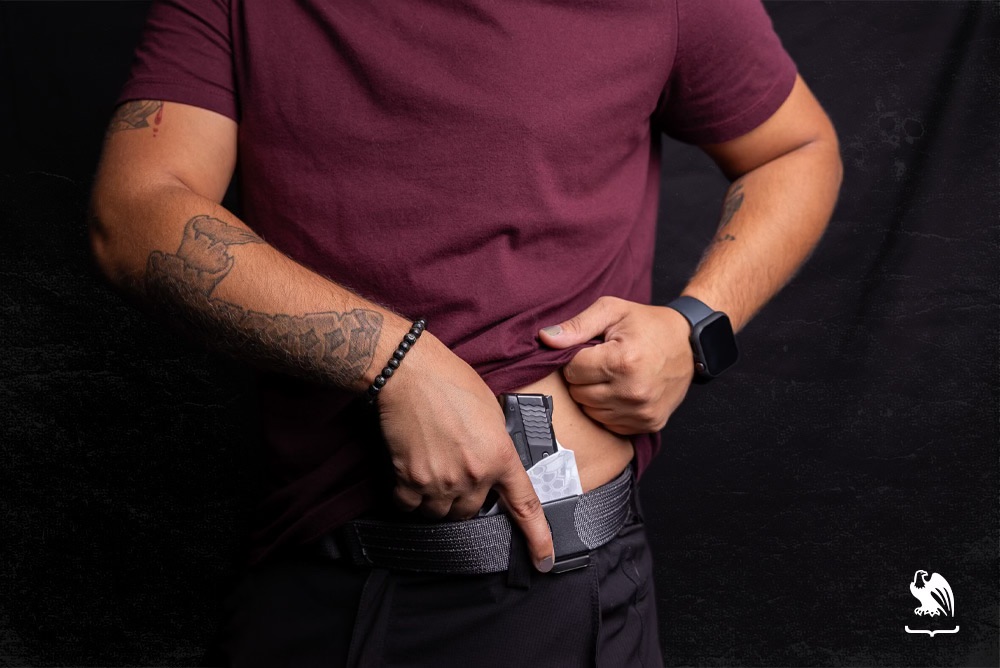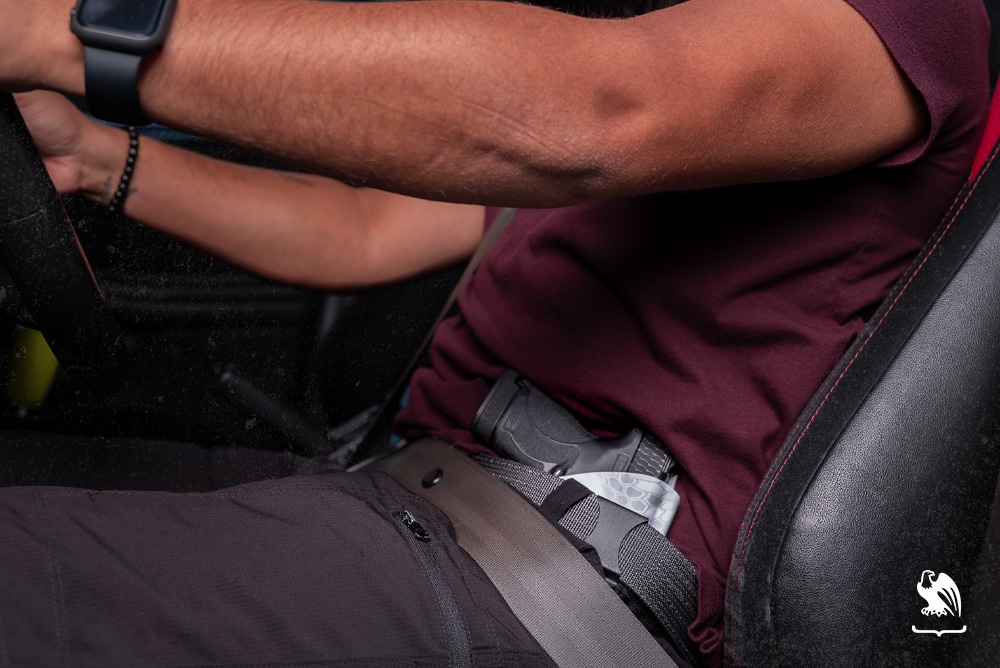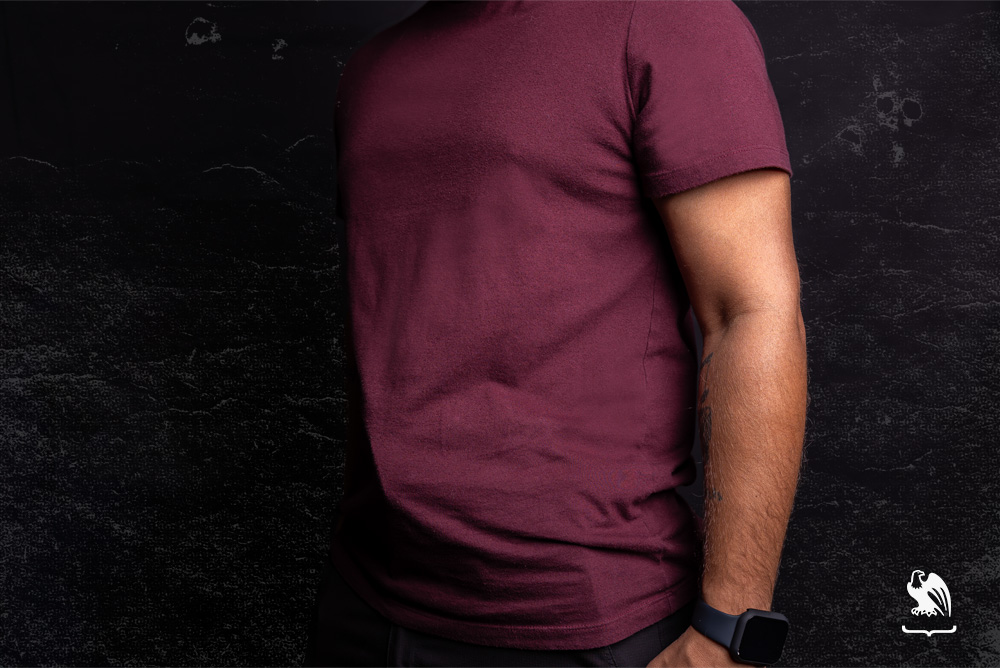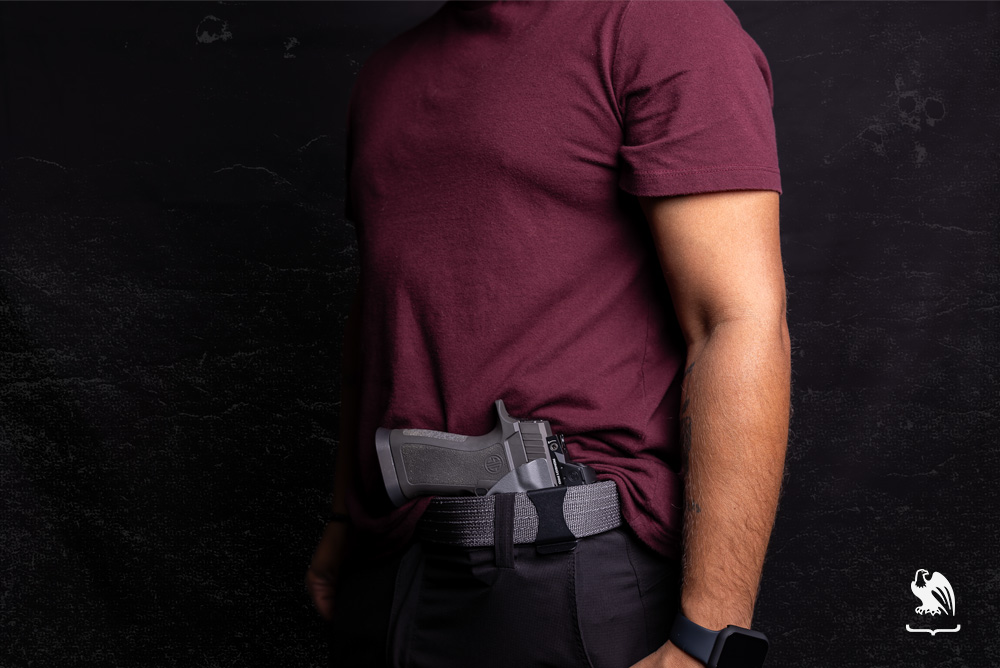Pros and Cons of Cross Draw Carry

If you’ve ever seen an old western, you know exactly what it looks like to cross draw.
Back in the day, cowboys would open carry revolvers on the opposite side from their dominant hand, which not only looked cool, but had some practical applications as well. But what does cross drawing look like in the modern world?
Cross draw carry is a method in which a holster is worn on the “weak side” of the body, and drawn across it with the dominant hand. Though not typically recommended for inexperienced shooters, cross draw is a popular carry position for those who spend a lot of time on the road.
Cross draw is a less common carry method than it used to be, but may be the right choice for people in specific circumstances. So while there are some downsides to this carry position, there are certainly applications where cross draw makes sense.
If you’re thinking about carrying cross draw, keep reading to learn more about the pros and cons of this method to help you determine whether it’s the right choice for you.
What is Cross Draw Carry?
Perhaps you’ve heard the term, but are still wondering, what is cross draw, exactly?
In simple terms, cross draw carry is when a shooter carries their gun on the opposite side of their dominant hand, and draws the firearm across their body. So, a right-handed shooter would keep their gun on the left side, lefties would keep the gun on the right side.
Today, this method is more commonly worn inside the waistband, though it used to be more common in the Old West, where cowboys would cross draw open carry revolvers to make room on their belts for other gear. So, assuming you’re not taking 500 head of cattle to slaughter, why bother with cross draw in the 21st century?
We’ll jump into the pros and cons of cross draw carry next.

The Case for Cross Draw Carry
Even though cross draw is an old method of carrying, it still has an application today, though it will certainly require a little more forethought than some other methods. Specifically, if you’re willing to spend some time (and money) on a belt and holster setup that makes sense for you, and do some practice, then this carry method might make sense.
Accessible Belt Setup
Cross draw was originally meant to make more room on a cowboy’s belt, and that same consideration still makes it a good idea for some folks today.
For example, in American cars, our seatbelt buckles sit at the 3 o’clock position, the exact same spot where some people carry their firearms. So, how long would it take someone carrying at that 3 o’clock position to respond to someone trying to carjack them? While driving, cross draw positions the gun away from the buckle and in much easier reach.
Additionally, cross drawing might allow you to put your gun in a deliberately awkward position. While this sounds strange to many civilian shooters, in the police world, keeping your taser and firearm in positions that are easy to mix up under stress is a recipe for disaster.
Cross draw is slower and more awkward: those two things mean that it may take more forethought to draw instead of an easy outside the waistband set up on the same side as your dominant hand.
Comfortable While Seated
As I mentioned above, drawing from cross draw is a very deliberate action, and is one that feels odd to people who have been using a different concealed carry method for some time. Just like any other method of concealed carry, it will take some practice to learn how to cross draw well.
This is especially true when drawing from a seated position. While appendix carry is uncomfortable but fast while seated, cross draw can be nearly as fast and is much more comfortable.
Since the main benefit I see of cross draw carry is that it’s easier than other methods to draw from while seated in a car, you’ll also want to practice drawing from a seated position, ideally in a car.
This might present some logistical challenges, however, as practicing your draw stroke in an apartment’s parking lot might well bring very unwanted attention from the local police department. However, with some training and some forethought into where you practice, cross draw might well be an ideal method for folks who do a lot of driving while concealing a firearm.

The Case Against Cross Draw Carry
Of course, any technique will come with some downsides.
While cross draw may be a good option for concealed carriers who do a lot of driving, there are a few negatives to consider that might be a dealbreaker for the average shooter.
Muzzle Sweeping
One of the major issues in drawing from a cross draw holster is that it means you will be drawing the gun in a fairly wide arc. That arc begins, possibly, with first sweeping your non-dominant arm. Then you might well sweep several bystanders before coming to your target.
By that time, you’ll have some side-to-side momentum built up, and it’s entirely possible that your shots will go wide of the target.
Practice is critical for cross drawers. Without some fairly serious training to make yourself precise and safe with this position, you could be putting yourself and others at risk.
Weak Hand Drawing
With cross draw, the firearm sits extremely close to the non-dominant hand. But, because of the biomechanics involved, it’s fairly hard to draw from these kinds of holsters with your non-dominant hand.
This type of draw, also known as “cavalry draw,” is a seven-step process that requires the shooter to have enough room to get their non-dominant hand all the way back and stick out their elbow a considerable distance.
In my mind, this evaporates many of the benefits of cross draw carry, as having to do a cavalry draw inside a vehicle could require you to open the door. That is, of course, about the last thing you would want to do when being carjacked, for example.
Most concealed carry methods present some impediment to drawing the gun with your non-dominant hand, but the contortion necessary with this method makes it a con worth considering here.
Concealment Issues
If you carry a large handgun cross draw, the butt of the gun sticks out from your body at an angle that is likely going to print under most cover garments, as it holds out the fabric a substantial amount.
Compared to cross draw, appendix carry and other forms of carry that are inside the waistband are typically much easier to conceal. Historically, cross draw has been the stuff of cowboys and the police: neither of those two groups had to conceal their firearms, generally, to stay out of legal trouble.
If you’re going to cross draw, you’ll need to wear some fairly bulky clothing that might work well in some places, but leaves folks in hot weather environments with fewer good options to conceal when using a cross draw holster.

Do I Need a Specific Cross Draw Holster?
With cross draw carry, the barrel of the gun has to face a different angle to make it easier to draw across the body. So, you would need a new holster specifically designed for cross draw were you to consider this method of carry.
A little bit of experimentation with an unloaded, thrice-checked, Sig P238 that I usually carry in the appendix position makes it pretty clear that a generic IWB holster is no substitute for a purpose-built model.
Is Cross Draw Carry Worth It?
Unless you have a specific reason to do so, most experts do not recommend cross draw for most people as their primary method of carry.
The cons somewhat outweigh the pros: sweeping a large arc while drawing and also making it harder to draw with a weak hand are serious downsides. This is especially true given that most people concealed carry for self-defense.
It’s entirely possible that if you find yourself in a defensive shooting, you may have to draw with your weak hand if your dominant hand is injured or if you need to use it to physically block your attacker. In circumstances like those, a method of drawing from concealment that requires finesse and training to do both well and safely might well not be the right choice for the average, armed citizen.
With all of those serious cons in mind, the major pros of cross draw, namely that it can be a lot more comfortable and accessible for people who have to conceal carry while driving, make this method of carry a good choice for those who drive a lot.
The bottom line is, despite its downsides, if you are willing to put in the time and practice, cross draw carry can be both safe and effective.
In short, then, I would not recommend cross draw to someone new to firearms and with little training. But, this method of carry certainly has applications that make sense, and it may well be the ideal carry method for truckers, delivery drivers, and others who have to drive long distances on a daily basis. Concealed carry tactics are tools, and cross draw is a tool that might well work for folks who need to carry while driving a vehicle.

Summary
Cross draw carry is a method in which the holster is placed on your weak side, and the gun is drawn across the body with your dominant hand.
Though there are some major downsides to this position, including the risk of flagging yourself or others while drawing and it being difficult to draw with your weak hand if necessary, it also has its advantages.
Cross draw can be an effective way to carry if you tend to drive a lot, as it’s far more accessible for right-handed users who might otherwise find it difficult to draw around their seatbelt.
Of course, there are some other considerations as well: if cross draw is something that you were taught and practiced well, it can be just as fast, if not faster, than other methods. As with all things in the firearms tactics world, safety, and effectiveness with cross draw is mostly dependent on your willingness to train until drawing and firing are second nature to you.
If you’re looking for a new IWB, OWB, or pocket carry holster, visit our Holsters by Gun Model page for Kydex holsters that are custom-made for your weapon of choice.
Interested in items beyond holsters? Check out our Resources Page for links to recommended products like lights, lasers, first aid, maintenance, and more, and browse our selection of apparel, and accessories at our website, vedderholsters.com.
To stay up-to-date on all the latest Vedder Holsters content and offerings, check out our blog and follow us on Facebook, Instagram, and Twitter. And be sure to visit our sister company, GeoGrit, for all of your American-made minimalist wallet needs.
